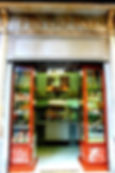A masterpiece of Neapolitan culinary art: the "sfogliatella"!
- Serena De Filippis
- Jul 16, 2018
- 3 min read
Hello hello!!
I know it's been forever since my last post, but I had a lot of things going on since Easter (plus the summer break of few weeks ago!)...
Anyway, let's not waste other time... Today, I want to write you about another iconic pastry of my Naples (yes, we have a few...): the sfogliatella! Probably most of you have never heard about this amazing delicious sweet, that's the reason why I have decided to dedicate it a post - and also because I am missing my city very much!!
First of all, the name "sfogliatella" (sometimes translated in English with "lobster tail", even though this is wrong because the two words do not refer to the same pastry in Italy) means "thin layer" because the texture of this pastry resembles stacked leaves.

Actually, in Neapolitan cuisine, we have two different versions of sfogliatella - so we can satisfy every kind of palate! The first one is the "riccia" (curly), the second one is the "frolla" (shortcrust). The difference lies in the shape and the dough used while the filling is the same.


The "riccia" - which by the way is the one that I prefer because of its "crunchiness" - is made with a super stretched and flattened dough, that is then brushed with a fat and rolled into a log. You then give them the seashell shape, fill them and bake until the layers separate, forming the sfogliatella's characteristic ridges.
The "frolla" has a round shape and the shell is made with sweet pastry dough, filled and baked until golden brown. The texture is completely different!
As most of the traditional Italian pastries and cakes, the origin of the sfogliatella appears to be a real "spy story" - set in the world of Campania's monasteries of 1600...
The “sfogliatella riccia” was in fact born in a monastery in Naples, the "Croce di Lucca" - situated not far from the Church of "San Pietro a Majella", in the heart of the city.

It seems, however, that the recipe of the period was extremely poor, not yet including ricotta cheese.
At the time, the churches of the ci ty used to compete in the production of sweets: the aim was to maintain the necessary relationship with the most important people of the city, by getting to them "through their stomach". The secret of the sfogliatella, with the complicity of three novices of the Sisters of the Church Croce di Lucca, however, was stolen and became heritage also of other convents.
Still, the secret remained within the monastic world.
The recipe of sfogliatella made its way to the cloistered nuns of the Convent of "Santa Rosa" on the stunning Amalfi coast (have you ever been there? British people literally go crazy for that part of Italy!!). There, some changes were made to the previous recipe, making sfogliatella richer and lustful: the nuns enriched the filling with the delicious ricotta of Agerola (you should really try it!!) and added also cream and sour cherries (in other words, they made what we call today "Santa Rosa sweets").
Again, however, the secret did not last long: the monastery was home to a young novice nun, the eldest child of a wealthy family in Amalfi - who became “friend” with a young man... Who was a pastry chef! The novice revealed the secret recipe of sfogliatella to this man - who, fortunately for all of us, unveiled it to the world and put an end to the monopoly of the monasteries!

The young pastry chef brought a significant change: he removed the cream and sour cherries, making the sfogliatella look more like it was in the version of the Neapolitan convent of the "Croce di Lucca", and giving to the sweet more or less the appearance it has today.
The name of the young pastry chef? According to some, it was the famous Pintauro, a pastry chef of Via Toledo (still existing) - one of the main city centre streets of Naples, known for its desserts and especially for the famous phrase "Ten' a' foll' Pintauro!" (“Pintauro’s shop is always crowded!”).
According to others, Pintauro wasn’t the confidant of the novice of Amalfi, but he intervened years after, launching this wonderful sweet treat to the public.
Have I made your mouth watering? I do hope so!!
I want to leave you and end this post with an amazing picture of Naples, that I took few years ago... I really wish you have the chance to visit my beautiful city, rich of art, history and of course delicious food!!

Have a fantastic weekend, and remember: you can't buy happiness, but you can buy a cake. And it's kinda the same thing!
xx Serena



